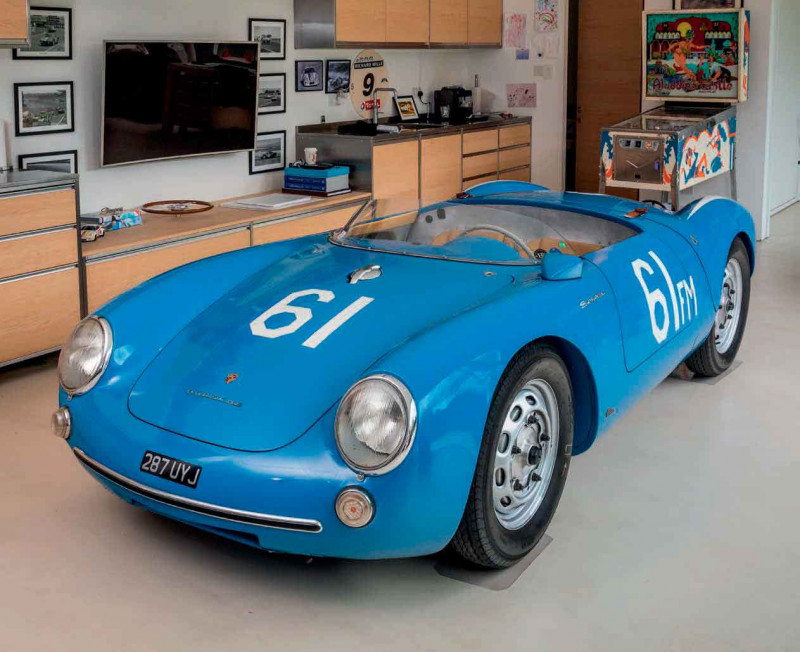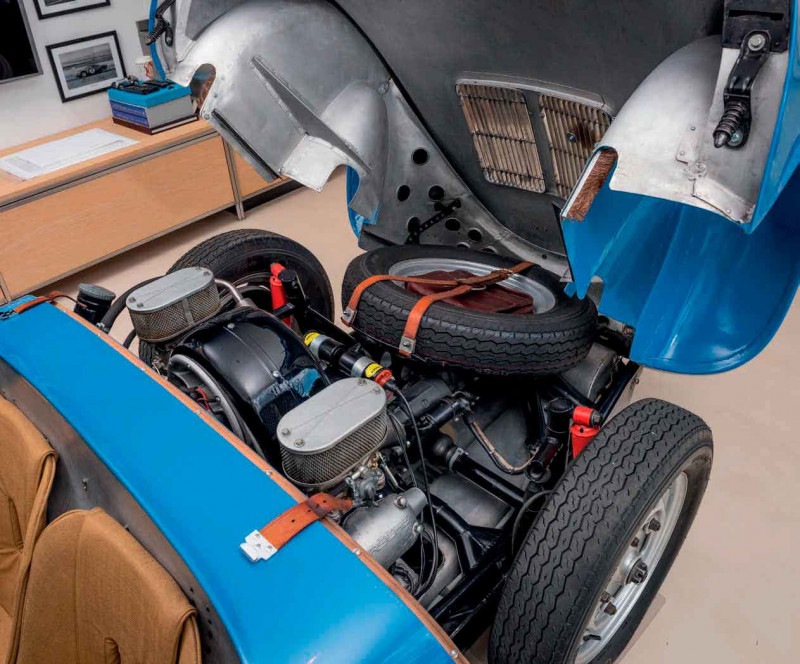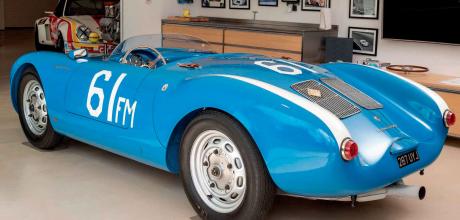The fourth Porsche 550 Spyder customer build
Porsche’s first purpose-built race car was the 550 Spyder, introduced in 1953 and instrumental in establishing the marque as a winner on the endurance racing scene. We get up close and personal with chassis 550-0020… Words Johnny Tipler. Photography Dan Sherwood.
THREADS OF THE WEBThe fourth Porsche 550 Spyder customer build
The 550 Spyder kick-started Porsche’s inexorable rise to motorsport supremacy in the 1950s and paved the way for the generation of Porsche prototype sports-race cars powered by the four-cam Carrera engine, as well as the 718 F1 and F2 machines. The bare bones of the 550 series are these: with antecedents in the 356-based, open-top, back-to-basics Spyders raced by Porsche agent, Water Glöckler, between 1949 and 1953, the 550 Spyder consisted of a simple ladder-frame chassis with independent torsion bar suspension all round, clad in an open-top aluminium body, made originally by Weinsberg — and then by Wendler — at Reutlingen. What is a Spyder? Essentially, an open cockpit two-seater roadster, perhaps with tonneau cover as weather protection.

The 550 Spyder body was permanently attached to the chassis and even the instrument panel was welded to the frame in an effort to optimise rigidity and prevent undue flexing. Power came from the 1,498cc Type 547 four-cam flat-four (developing 110bhp at 6,200rpm) or the much rarer factory small-bore 1,089cc version, good for 72bhp at a screaming 7,000rpm. Crucially, achieving optimum chassis and driveline balance, the engines were mounted amidships. It’s worth reminding ourselves the prototype 356 also had its engine ahead of the rear axle, just like those 1930s Silver Arrow Auto Unions and the tiny post-war 500cc Formula 3 Coopers.
THE CAR’S ATTEMPTED MODERNISATION IN RELATION TO ITS SWISS HILL-CLIMBING EPISODE
The 550 Spyder was Porsche’s first purpose-built race car, making its debut at the 1953 24 Hours of Le Mans. In only Porsche’s third year contesting the race and its second with works entries, the Stuttgart cars were midfield runners, quicker than the tiny Panhards, but without the oomph to tackle the big Ferraris, Jags and Nash-Healeys. Bent on a class win, Porsche fielded a 1,090cc 356 SL Coupé, as well as a pair of 550s running single-overhead-camshaft 1,495cc flat-fours, giving 98bhp at 6,000rpm. These cars were the starting point for over half a century’s worth of evolutionary sportsracing engineering.
HIGH-CARB DIET
Though the Fuhrmann-designed four-cam engines were available for Le Mans in ‘53, fuel quality was unreliable, which is why Porsche elected to run the SOHC engines, each cylinder-bank fed by vast Solex 40 PII downdraught carburettors. The cockpit was so confined that the steering wheels were removable to ease driver ingress, though presumably any driver doing the trad Le Mans sprint-across-the-road-and-jump-in start would have had to make the best of it. Windscreens could be wraparound or single shields, on the Spyders, that is — the duo of debutants at Le Mans were configured as 550 coupés (chassis 550-001 and 550-002), designed by Porsche race engineer, Wilhelm Hild, and clad in aluminium panelling made by C.H. Weidenhausen of Frankfurt. Their crews were Helmut Glöckler and Hans Herrmann (550-001) and journalist-racers Richard von Frankenberg and Paul Frére in (550-002). These two 550 coupés circulated in tandem, and as twenty-four hours of hardcore racing drew to a close, team manager, Huschke von Hanstein, lined up the two Porsches in a dead heat for fifteenth place. Event organisers were less than impressed, classifying the von Hanstein/Frére car in fifteenth place and the Glöckler/Herrmann car in sixteenth come final standings, results determined on account of 550-002 having covered a fraction more distance because of being positioned further back on the starting grid. “An excellent performance from a car developed from the utility, Volkswagen,” said Motor Sport in its July 1953 edition, such was the patronising perception of Porsche at the time.

Any surviving 550 Spyder chassis is a significant relic of Porsche’s past, representing the foundations of the manufacturer’s very first attempt at racing. Sure, Professor Ferdinand Porsche had a lifetime’s history of designing race cars, including the aforementioned mid-engined Auto Unions and the elegant post-war Cisitalia, but Porsche was a nascent company starting out on its own. With Project 550, the fledgling brand demonstrated a sense of ‘purpose regained’ after the war, when it became clear modified 356 coupes wouldn’t be competitive in international racing. The 550 was to show its true quality, however, on the other side of the Atlantic in late 1953, when Porsche earned the right to use the Carrera epithet after winning its spurs in the legendary Mexican road race, La Carrera Panamericana, by coining a class win. It wasn’t even a works driver at the helm, and the car had recently been sold off. That mattered not — a class win is a win, and as ever, race success had a direct impact on showroom sales and marque status.
BUSY SCHEDULE
Three years earlier, the World Manufacturers’ Championship was introduced, and by 1953, La Carrera Panamericana had joined the series alongside the 12 Hours of Sebring, Mille Miglia, Le Mans, the 24 Hours of Spa, 1,000km of Nürburgring and the RAC Tourist Trophy. Ten Porsches ran in the 1953 Carrera Panamericana’s sub-1,600cc Sport Menor class, including two 1,500cc (pushrod) works 550 Spyders entered by New Yorkbased European sports car importer, Max Hoffmann, for drivers, Karl Kling and Hans Herrmann, supervised by Huschke von Hanstein. Sadly, both cars retired early due to suspension and steering failure, but a 550 coupé (fresh from Le Mans) entered and driven by privateer, José Sala Herrarte Ariano (ably assisted by co-pilot, Carlos González), fared much better, taking the class win. Coupled with Herrmann doing the same with a podium-finishing Spyder-bodied 550 at the same event a year later, plus a closely followed fourth-place finish for privateer, Jaroslav Juhan, in charge of the no.56 550 Spyder, these victories contributed to Porsche’s reputation as a force to be reckoned with in endurance racing and led to the company announcing the fact by adopting the Carrera nameplate for production model designation, a tradition continuing to the present day.
BUNKER USED THE CAR TO FINISH AT WATKINS GLEN’S GRAND PRIX AND WON THE PORSCHE RACE AT NASSAU
Works 550 Spyders raced at the Mille Miglia in 1954, as well as the year’s Reims, Eifelrennen and Le Mans endurance events in the hands of (among others) Herrmann, Johnny Claes and von Frankenberg, scoring several class wins against formidable opposition from Borgward, EMW, OSCA and Maserati. The first cars were delivered to private owners towards the end of 1954, and the design altered subtly when chassis 550- 0016 emerged — excepting the two original coupés, the upright headlights characterising the preceding run of cars were massaged into a slightly more sloping position, while the curvaceous hindquarters were smoothed out.
One of Germany’s best (and most underrated) drivers, Herrmann was responsible for another piece of Porsche folklore, when he and his 550 Spyder co-driver, Herbert Linge, sped beneath a railway crossing barrier, narrowly missing an oncoming train, during the 1954 Mille Miglia.
Defying the Rome Express, they breezed underneath the lowered barrier arm unscathed, and sped on to sixth overall and another class win. “We were going very fast, but we had a very good road-book,” Linge told me in recent years. “We knew there was a barrier coming, but I didn’t see anything because I was looking at my book. Suddenly, Hans put an arm around me and pushed down on the back of my head to ensure I was below the level of the cockpit. We sailed under the barrier!”
Born in Weissach, Linge joined Porsche as an apprentice in 1943, and in 1948 was the first mechanic hired when the firm relocated from Gmünd in Austria to Stuttgart-Zuffenhausen, where he was involved in the construction of the original 356. As well as an extensive race and rally-driving career, exclusively in Porsches, Linge was chief test driver during the 1950s and ’60s, closely involved in the development of all engine types, from the original flat-four to the four-cam, the flat-six, the flat-eight and flat-twelve. There’s a dramatic difference between a four-cam engine and the regular flat-four, though Linge claims the former be a very reliable unit, albeit quite a complex construction. “The four-cam engine was too expensive for normal production and repair,” he says. “It was always going to be a race car engine. That’s why, not long after, the six-cylinder engine was introduced — it was much cheaper to manufacture and maintain.”
According to former works race driver and current factory historian, Jürgen Barth, only 137 examples of the 550 Spyder were built (Porsche Book 3), which makes a low-volume run of hand-made units an interesting proposition. Over the years, I’ve written several features focusing on the work of marque specialist and classic racer, Andy Prill, as well as snapping his exploits in a 356 on La Carrera Panamericana, at which he is an old hand. Needless to say, I was intrigued when Classic Porsche editor, Dan Furr, invited me to examine the 550 Spyder which recently passed through the Prill Porsche Classics workshop in Healstead, Essex.
FOUR TO THE FLOOR
Chassis 550-0020 was the fourth customer 550 Spyder to be built (as opposed to works cars), fitted with Type 547 flat-four, engine number 90006, and rolling off the Zuffenhausen production line on February 2nd 1955. It was originally finished in a dusky blue akin to Aetna Blue (a shade featuring on Porsche’s colour chart in the late 1950s) and emblazoned with snazzy white tail darts, which were a popular decorative feature shared with other 550s, including James Dean’s 550, known as Little Bastard. The blue hue was paired with a tan interior. Perhaps no surprise, then, to learn the car was ordered by Max Hoffman. He sold it to Art Bunker, who owned a Porsche–Volkswagen dealership in Kansas City, Missouri, and raced a 356 in Sports Car Club of America (SCCA) events. Bunker entered 550-0020 into the 1955 23 Hours of Sebring, qualifying on the notoriously rutted airfield circuit, but pulling out of the actual race.
On September 9th 1955, Bunker used the car to finish at Watkins Glen’s International Sports Car Grand Prix, and won the Porsche race at Nassau Speed Week on December 10th, placing second in the same race the following year. This potent Porsche was campaigned in other SCCA events during the same seasons, scoring a few top ten finishes, but generally recording midfield results. By now, the car was painted pale custard yellow, possibly after a crash. Bunker upgraded slightly by acquiring 550A-0111 to tackle the Sebring enduro in March 1957, putting 550-0020 up for sale. As a footnote, having raced a 718 RSK in 1959, his last competitive outing was the 1971 24 Hours of Daytona, placing forty-fourth in a 911.
Chassis 550-0020 found its way into Prill’s hands by a rather circuitous route. Art Bunker sold the car to a Swiss hill-climb exponent, though not contemporary Swiss champion, Heini Walter, who also ran a 550 Spyder (chassis 0016). By 1960, 0020 was competing with RS 60s and, in a bid to modernise his 550, the owner removed the bodywork and replaced it with a body reminiscent of an RSK, which had different side grilles and rear air vents, plus an elongated nose, making it eight inches longer than the 550, as well as being three inches slimmer. “The Swiss guy had an accident and that’s when he took the 550 body off and updated it,” Prill confirms. “0020’s original body was probably scrapped.” Eventually, the chassis was relieved of this charade and, along with the running gear, ended up in a Hamburg motoring book shop, relegated to being used as a desk and shelving with automotive books piled on top! Next thing, the store owner, Martin Schroeder, sold all of the Porsche’s surviving componentry to Zurich-based connoisseur, Marco Marinello, proprietor of Elevenparts, who acquired a 550 Spyder body from (father of classic 911 racer, Marc) Pierre de Siebenthal’s chassis 0079. Marinello promptly assembled the chassis and powertrain, clad in the replacement bodywork, and sold the car as a project to Belgian Porsche specialist, Walter Pauwels (father of 993 Carrera RS racer, Pascal). He, in turn, despatched it to experienced gentleman driver, Mark Finburgh, who had the 550 body restored and refitted. According to Prill, the car passed to collector, Luay Allawi, after Pauwels’s death. DK Engineering carries out a lot of work on examples in Allawi’s collection, which is how the 550 came into the hands of its current owner, who was known to the company. He’d rather remain anonymous, although since the fresh restoration and engine rebuild at Prill Porsche Classics, he has raced the car at Laguna Seca and has used it to participate in the Mille Miglia. He’s also not shy of driving it to the odd Ace Café meeting on London’s North Circular.
In readiness for the vintage Porsche’s new lease of life, Prill had the body restored again, and also rebuilt the suspension, the engine and gearbox — a company speciality. “At the time, I didn’t have anyone in the UK that I was happy to use for the restoration of a 550 body, which is why my team removed the bodywork and sent it to Harald Hackenberg Restaurierungen in Leverkusen,” he reveals. Since then, he’s found a service provider in Britain who is more than up to the job. No such searching was required as far as the mechanical stuff was concerned. Indeed, given Prill’s expertise in this department, I’m curious to know what he found when dismantling the engine, given the car’s long history and the attempted modernisation in relation to its Swiss hillclimbing episode. “It was subject to a full engine rebuild,” he confirms. “It needed everything, including barrels and pistons. The unit was pretty bad inside and needed a lot of work to put right. We actually converted the engine to having a plain bearing crankshaft in the interests of reliability and longevity — you can’t get more than a few thousand miles out of a roller-bearing race unit without servicing it all the time. Within period, this was fine, but today? It’s a big deal.”
PORSCHE’S FAST FIX
Had there been an attempt at tuning? “At some point in the car’s early history, a factory upgrade kit was installed. This setup was designed to move the distributors from the inlet camshafts onto a V-drive belt driven by the crankshaft, which was quite a common thing to do in period. It’s more to do with reliability and more accurate timing than performance — it’s all very well driving the distributors off the inlet camshafts, but they’re at the very end of the complicated valve drive, so any wear that developed would scatter the timing around. This is what Porsche was discovering, which is why they needed to find a technical solution. And that only became apparent once these cars were being raced. Initially, only the works engines were converted, but soon after, Porsche made the upgrade kit available to its customers. We’ve retained this equipment because it’s by far the best thing to do. Put it this way, I was chasing the car around Goodwood from behind the wheel of a 904 and I could hardly keep up! The owner of this car doesn’t want to race it particularly often, but when he does, he’s bloody fast.” Expect to see man and machine in action at an upcoming Goodwood Revival, then.
Going back to model history, the 550 Spyder was discontinued by close of 1958, morphing into the 718 RSKs, RS 60 and RS 61, which retained the 550’s short wheelbase, but introduced wishbone rear suspension and coilover dampers in places of the 550’s swing axles. Sir Stirling Moss raced all variants and also owned an RS 61 (chassis 718-070, fettled, incidentally, by Andy Prill and Adam Lichtig, and a sibling of his 1961 Targa Florioleading car). “I thought of them as very competent, very reliable cars, but not likely often to win outright,” Stirling once told me. “Things changed, however, when Porsche brought out the RSK and increased displacement to two litres. These cars were then really very good, very reliable, almost equal with Ferrari.” Moss drove a 550A Spyder with Jean Behra at the 1958 1,000km of Buenos Aires, finishing on the same lap as the two Prancing Horses romping home to first and second place after six and a half hours of racing. “I had them fit a 1.6-litre engine,” Moss recalled, “and it revved to 7,400rpm against 7,100rpm for the 1.5-litre unit. That’s an extra 300rpm from just 100cc!”
Heady days, but, to an extent, the 550 Spyder is still with us in style and spirit: designing the 986 Boxster, Harm Lagaaij inevitably referred back to Porsche’s classic antecedents. The 987 Cayman also takes its cue from the 1953 Le Mans and Panamericana 550 Coupé. That’s a pretty amazing legacy — from one state-of-the-art sportscar to another, separated by five decades of automotive evolution.
Above The car’s enthusiastic owner isn’t shy of putting his stunning historic Porsche to work at the track. Below Forget creature comforts — the 550 Spyder was designed first and foremost as a race car, providing the bare necessities, even in more civilised street trim. Above ‘Fuhrmann’ Type 547 DOHC flat-four neatly packaged in the 550 Spyder. Below Post-event poster commemorating fifth and final running of the Carrera Panamericana Mexican sports car racing challenge. Above It’s great to see a 550 in a vibrant coat of colour instead of standard silver.
PORSCHE EARNED THE RIGHT TO USE THE CARRERA EPITHET AFTER WINNING ITS SPURS IN THE MEXICAN ROAD RACE


